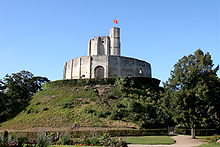Cutting of the elm
After the meeting, Philip ordered the tree cut down and hacked to pieces, sending the message that he would offer no quarter to the English.A quite different account is given by the Minstrel of Rheims (c. 1260), a thirteenth-century historical fiction:[4] King Richard sent a message to the counts of Sancerre and of Barre, telling them that they took the king's bread and gave him nothing in return but if they were brave enough to come to the elm tree at Gisors, he would consider them truly courageous.
The French nobles sent the message back that they would come the next day, at the third hour, to cut the tree down, in spite of him.
When the English king heard that they were coming to cut down the tree, he had the trunk reinforced with bands of iron, that were wrapped five times around it.
They stopped at the elm tree, tore off the bands, and cut it down, in spite of all resistance.The event has been used in the history proposed by Pierre Plantard and other pseudo-historical theories.
In this context, the Cutting of the elm was portrayed as marking the split between the Knights Templar and the Priory of Sion.

